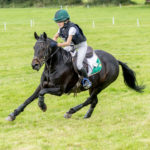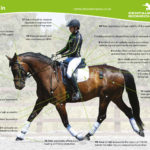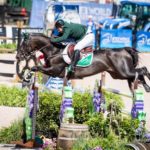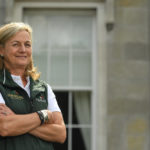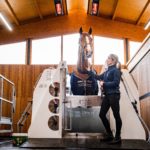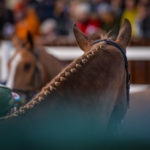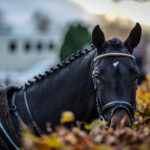Anna Merveldt: Developing flexibility, responsiveness to aids, and balance in the young horse
- 3 March 2021, 19:48
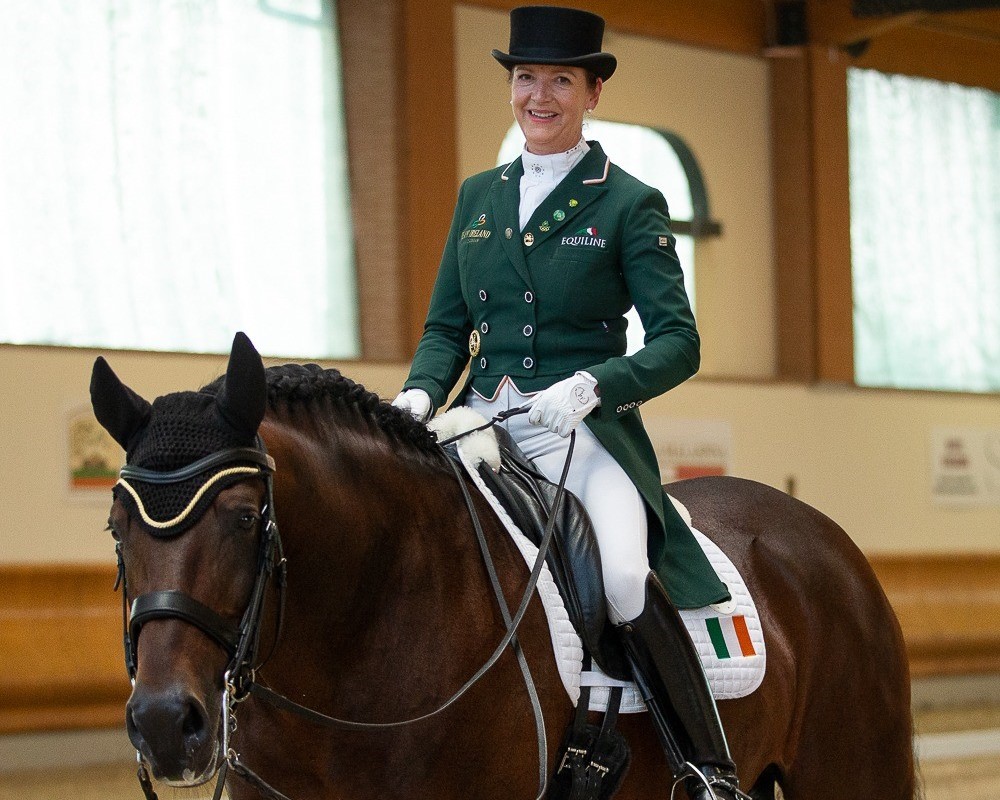
Anna Merveldt and Esporim were part of the dressage team that helped Ireland secure Olympic team qualification for the first time in the history of the Olympic Games (Photo: Marta Fusetti)
Welcome to the final part of our young horse training series. To conclude this series, we turn to one of the fastest growing equestrian disciplines in Ireland – dressage.
Many will remember that historic day in 2019 when the ‘Girls In Green’, Anna Merveldt, Judy Reynolds, Heike Holstein and Kate Dwyer, secured Olympic team qualification for Ireland after a stunning performance at the Longines FEI European Championships in Rotterdam. This was the first time in the history of the Olympic Games that Ireland qualified a dressage team. A unanimous dream hatched in early 2019 led to that achievement, but arguably nobody had to fight harder for it than team member Anna Merveldt, our expert for this week’s part of the series.
Anna made her international debut for Ireland in 1988 and has since represented her country at two Olympics, seven European Championships and three World Equestrian Games. However, in 2019 when the possibility of fielding an Irish team became a possibility Anna was without a Grand Prix horse.
Anna Merveldt and Esporim’s journey:
Anna Merveldt (AM): My journey with Esporim started back in 2019 when I was inspired by the dream of being part of the first Irish dressage team to qualify for the Olympics. Kate [Dwyer], Judy [Reynolds] and Heike [Holstein] were all doing really well, and I was really interested in being involved in a team, but I didn’t have a Grand Prix horse at that time.
One of my pupils, Giovanna Mazza, had bought a beautiful Lusitano stallion called Esporim, he was 10 at the time and well established at Intermediate I level but hadn’t done any Grand Prix competitions. He had an incredible temperament though, and a real willingness to learn so I asked her if I might borrow him to help Ireland qualify a team for the Olympics.
Incredibly, she agreed and I can’t thank her enough! Within a few months he was riding at five-star Grand Prix level. It just goes to show that temperament is so important – when you have a horse with a willingness to learn, who doesn’t get stressed out you can come on leaps and bounds.
In Rotterdam [at the Longines FEI European Championships] our dreams came true and we helped qualify an Irish team for the Olympics. It was such a special moment. Esporim has really gone from strength to strength and I am incredibly proud of our achievements. We will hopefully go to the World Cup Qualifier in ‘s-Hertogenbosch next and with a bit of luck we will qualify for the World Cup final.
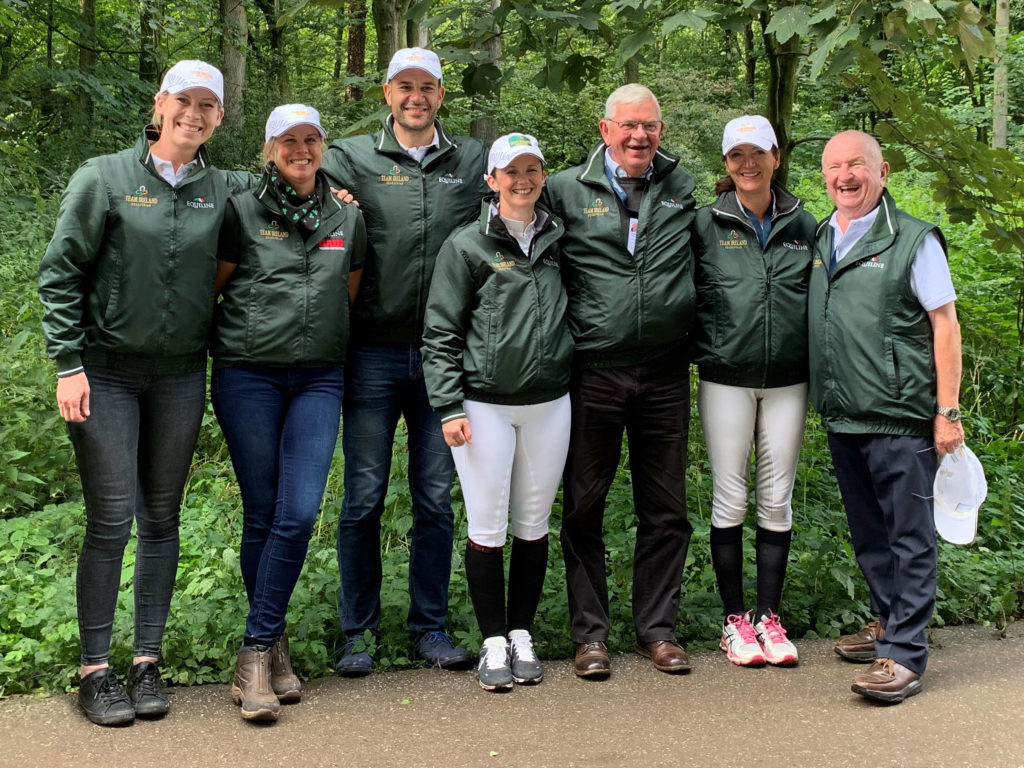
(L-R) The dressage team of Kate Dwyer, Heike Holstein, Milan Djordjevic (Irish Dressage Chef d’Equipe), Judy Reynolds, High-Performance Dressage Director Johann Hinnemann, Anna Merveldt and Horse Sport Ireland Acting CEO Joe Reynolds
Q1. Dressage is one of the fastest growing equestrian disciplines in Ireland – what do you think has led to this growth in participation?
AM: Ireland is a horse country. There’s tradition in Ireland when it comes to horse sport and breeding. I think it was only a matter of time before the sport of dressage started to grow in Ireland and I am delighted to see that it has.
Ireland has long been very successful in eventing and perhaps the interest in dressage has developed through that. People began to realise the significance of the dressage phase and wanted to improve their dressage, so I think that has led to more of an interest.
Several senior riders have competed at a high level over the years, but the rise of social media has certainly contributed a lot to the promotion of the sport. I think these reasons combined have contributed to the growth we are seeing.
Q2. What do you love most about Dressage?
AM: Well of course I love the buzz of competition, the challenge of always trying to improve your horse and improve scores. But, what really gets me is when you feel that you are in perfect balance and harmony with the horse and you realise that the horse is truly enjoying themselves. It’s an absolute joy to achieve and experience that.
Q3. What are the fundamental qualities you look for in a dressage horse?
AM: The quality of the paces is very important, and a good active hind leg is the key to everything.
In the walk I am looking for a good over-track (the hind foot should tread over and land in front of the print of the front foot) and that the horse is using his whole body. If the horse is in any way restricted, you need to think about the impact that might have because you need freedom of movement.
In the trot I am looking for nice, long, rhythmical strides. A big flashy trot can be deceptive, be sure to pay attention to the hind legs and not just the front legs. We want the hind leg to be just as flashy as the front leg, which is often not the case. A quick, active, well-positioned hind leg is paramount. In canter you are looking for a well-defined three beats and an uphill tendency.
Rideability and temperament shouldn’t be overlooked. The horse must give you a good feeling when you get on, you are striving for lightness and balance – that is either in your young horse or it’s not. When you think of what you will be expecting the horse to do at the top level, the arenas they will need to perform in, all the associated travelling – this is where the temperament becomes very important.
Conformation is important, but I have seen many horses with poor conformation and they still end up being extremely good dressage horses. If you have a horse who is completely on its forehand or very high behind that’s going to make things difficult.
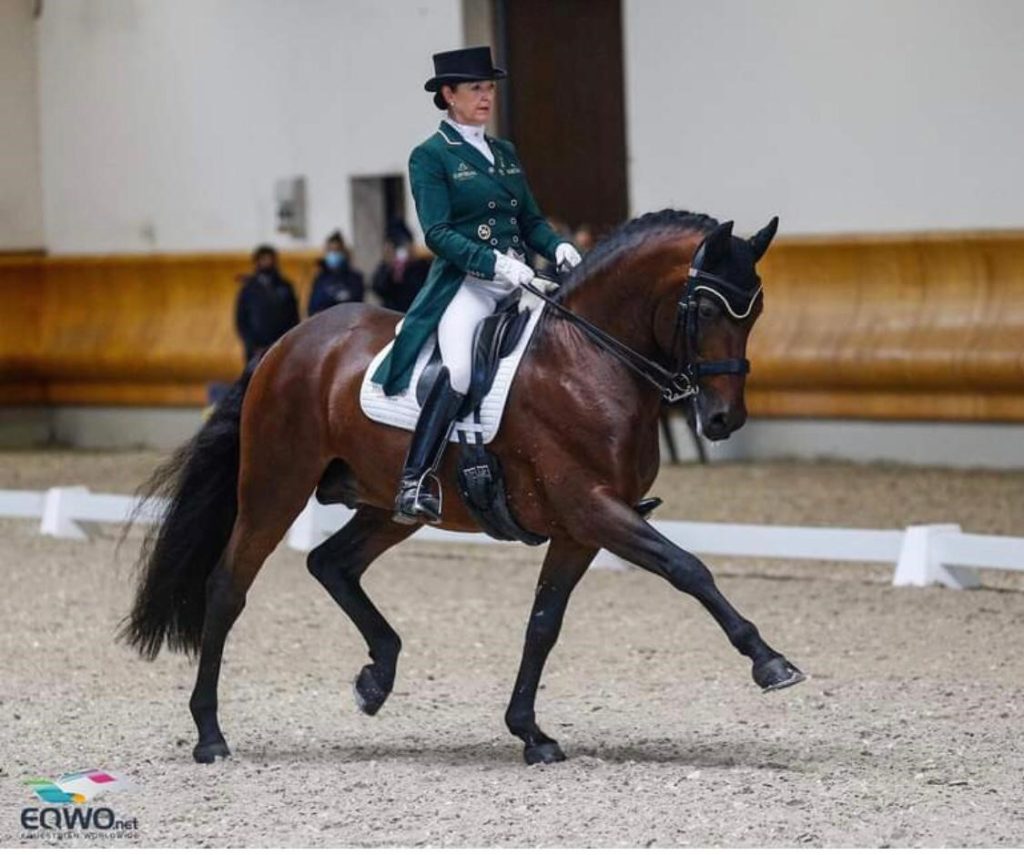
The quality of the paces is very important, and a good active hind leg is the key to everything, pictured is Anna Merveldt and Esporim (Photo: EQWO.net)
Q4. Ireland currently excels in the breeding of show jumpers and eventers, what advice would you have for Irish Breeders thinking of breeding horses for the dressage market?
AM: Irish horse breeders are world renowned and Irish horses are well known for being sound, well-tempered, rideable horses. I would just say that these are the hallmarks of any top competition horse and the sport of dressage is no different – so these things should not be dismissed if considering breeding a horse for the dressage market.
Q5. When a horse is just starting out with its training under saddle, what are some of the key traits/characteristics you are looking for in the horse at this stage?
You don’t do anything different with a dressage horse than you would with a jumping horse.
AM: I would always advise owners and riders to start by assessing what you have. Start with a physical assessment – is the horse well-muscled, is he balancing out nicely, does the horse have any issues that you need to address in your training. Next consider the horse’s temperament – is he super spooky or lacking in confidence. Riders need to know what they are going to be working with.
In your four or five-year old horse you are going to be concentrating on obedience, trust and confidence. Those are the things you start working on and riders/owners need to understand that the early stages of a horse’s training cannot be rushed – be willing to take your time with all young horses.
When you are confident that the horse knows the aids and is responding to them obediently and with confidence and trust, then you start very slowly introducing various activities. You want to be hacking, loose schooling, lunging and doing bits of pole work until they get up to a good standard. You don’t do anything different with a dressage horse than you would with a jumping horse.
Q6. What advice would you have for a rider training a young horse who is just starting out under saddle?
AM: You are going to have to make sure that you are stabilising the horse’s balance. The most important thing here is that the horse accepts and understands your half-halt. The half-halt is the most frequently used aid in riding. It has many functions:
- To alert the horse and make him attentive, it is used every time before starting a new movement.
- To make a transition to a lower pace.
- To slow down the pace.
- To improve/regain collection and/or re-shape and re-balance the horse while in motion.
- To improve balance, thus not allowing a horse to lean on the bit or to go on the forehand.
The most important part of the half-halt aid is the weight aid (sit up and broaden your chest). Simultaneously apply the forward driving aids pushing the horse into a non-allowing hand. Immediately when you feel that the horse is beginning to react, you should answer with a slight easing of the contact. (Reference: Horse Sport Ireland Coaching Manual)
It is important that the reins do not act in a backwards manner; the horse should be ridden from behind, forward into the hand. How strong a half-halt is applied depends on the horse’s degree of sensitivity and on the rider’s skill. The aim is to achieve the result with almost unperceivable aids.
If you have a very free moving horse, you can’t always be riding backwards if you do that you are going to ruin his natural pace and balance. Strive to always ride forward and to have a forward-thinking contact. My keen horse must learn to understand my half-halt so that if I think to myself ‘Oops I am losing him’ that I can half-halt, rebalance and proceed with a forward-thinking contact again.
Q7. A four-year-old horse may be required to show lengthened strides in trot and canter – what would a Judge be looking for here and what are some of the common pitfalls?
AM: A judge is going to look for an uphill tendency, lightness of the forehand, balance, lengthening of the horse’s frame, rhythm, and suppleness. The most common issue would be that the horse starts progressively getting faster as opposed to lengthening the stride. When this happens the horse loses balance, gets heavy in the hand and you will start to get uneven steps.
When I am training, I tend to ask for lengthened strides on a very large circle – when I have a tiny bit of bend it’s that bit easier for the horse. I also only ask for the lengthened strides over short distances to begin with so that you establish in the horse that he carries himself. As soon as the horse falls onto the forehand you need to half halt, rebalance, and try again. Doing this in rising trot at the beginning is no harm.
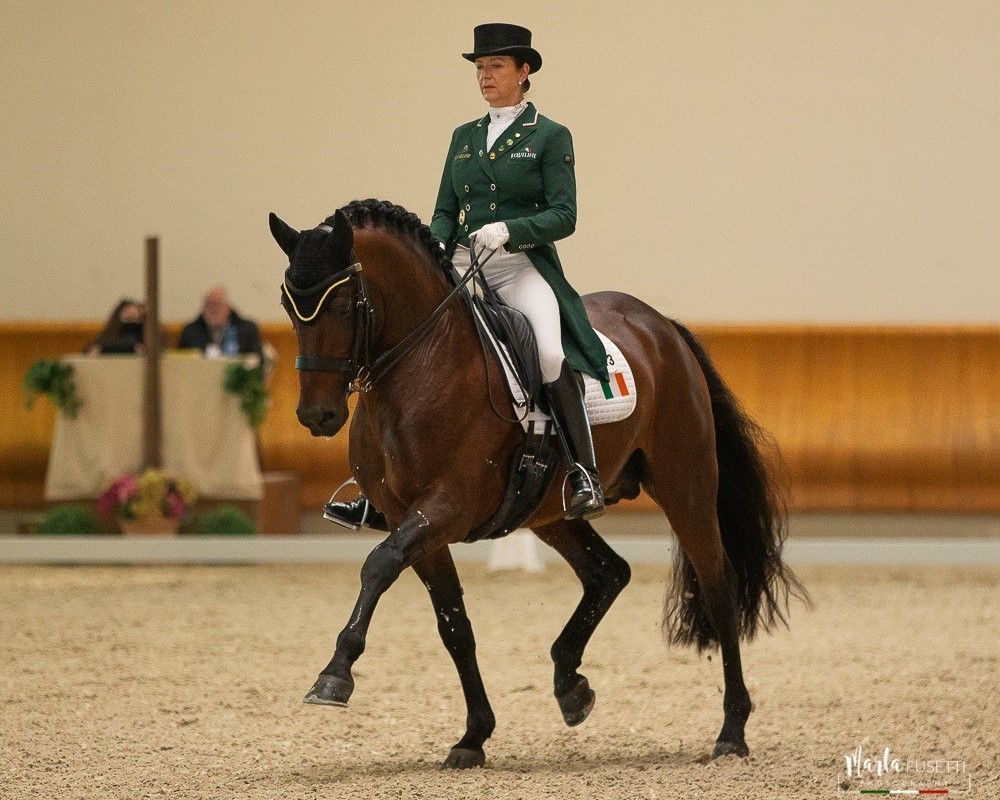
A judge is going to look for an uphill tendency, lightness of the forehand, balance, lengthening of the horse’s frame, rhythm, and suppleness in extended work, pictured is Anna Merveldt and Esporim (Photo: Marta Fusetti Photography)
Q8. What advice would you offer to riders/owners in advance of taking their young horse to their first competition?
Horses don’t forget the good or the bad so ideally the first experience should be a good one.
I would advise taking your horse away from home to go schooling, so that you can see how the horse travels, and nobody is under any pressure or getting stressed, you can just take your time. You want to make it a nice experience. Horses don’t forget the good or the bad so ideally the first experience should be a good one.
Q9. How would you know if your four-year-old horse is ready for their first competition?
I think the rider knows themselves when they are ready. If you feel confident that you and your horse have achieved the basics, you can ride the test quietly through at home without having any big issues, your horse is on the aids, bending equally left and right that’s more or less what you need to have achieved in advance of your first competition.
Q10. You’ve gone to your first competition with your young horse and you receive comments from the judges like ‘horse is tense’, ‘horse not accepting the contact’ or ‘losing connection in the transition‘ – what are your initial thoughts and what advice would you have for the rider?
It’s up to the rider to assess where that behaviour came from – is there something missing in the basic training or was the horse not acting its usual self because of the new surroundings. If the basics weren’t there to begin with you need to take a step back and take your time to really establish the basics. If the horse was tense because of the competition atmosphere, I would recommend a few more schooling outings in a stress-free environment.
-
Popular

-
Latest









